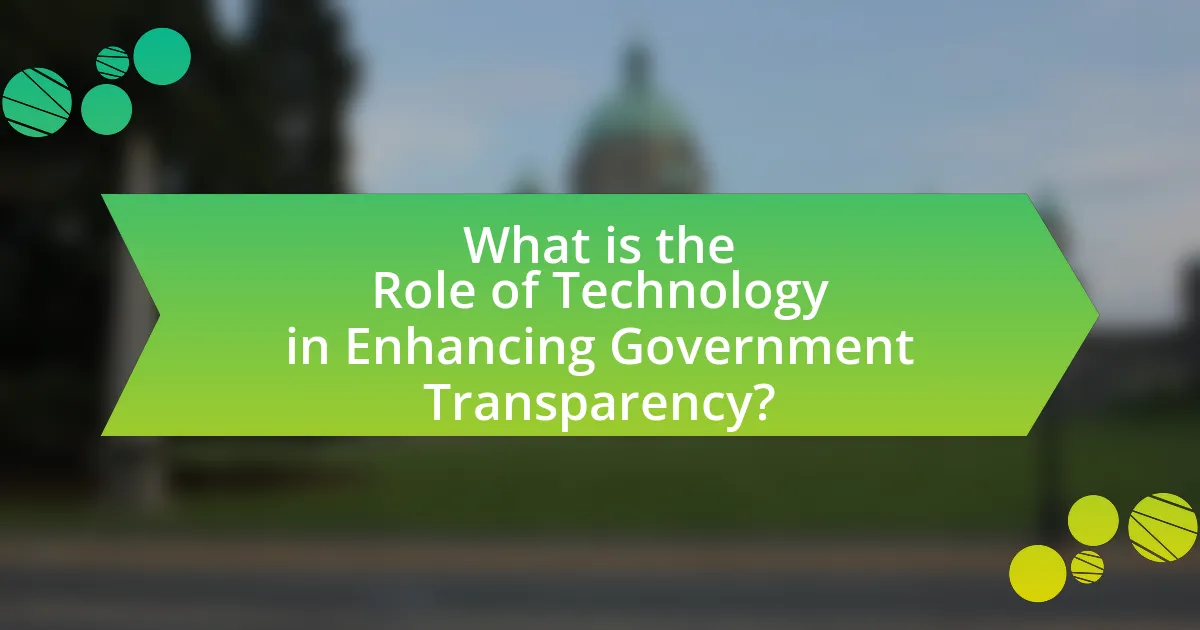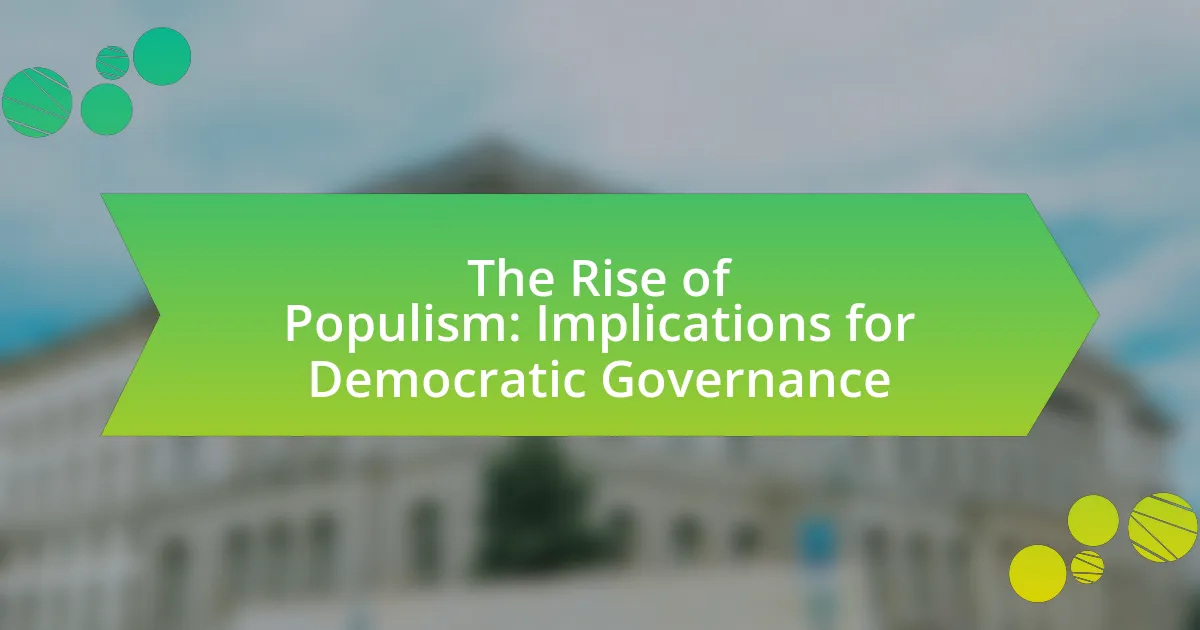The article examines the critical role of technology in enhancing government transparency, emphasizing how digital platforms facilitate access to information and promote accountability. It discusses various technologies, including open data initiatives, blockchain, and e-governance systems, which improve public access to government operations and foster citizen engagement. The article highlights the importance of transparency in democratic societies, detailing its benefits for public trust and accountability while addressing challenges such as data security and accessibility. Additionally, it outlines best practices for implementing transparency technologies and explores future trends that could further enhance government transparency efforts.

What is the Role of Technology in Enhancing Government Transparency?
Technology plays a crucial role in enhancing government transparency by facilitating access to information and promoting accountability. Digital platforms enable citizens to easily access government data, such as budgets, spending reports, and legislative documents, thereby fostering informed public participation. For instance, the implementation of open data initiatives allows governments to publish datasets online, which can be analyzed by citizens and watchdog organizations, leading to increased scrutiny of government actions. According to a 2020 report by the World Bank, countries that adopted e-government services saw a significant improvement in transparency and citizen trust, as these services reduced opportunities for corruption and improved service delivery.
How does technology facilitate transparency in government operations?
Technology facilitates transparency in government operations by enabling real-time access to information and data sharing. Digital platforms, such as government websites and open data portals, allow citizens to easily access public records, budgets, and decision-making processes. For instance, the U.S. government’s Data.gov provides access to thousands of datasets, promoting accountability and informed public participation. Additionally, technologies like blockchain enhance the integrity of transactions and records, ensuring that information is tamper-proof and verifiable. Studies have shown that increased transparency through technology leads to higher public trust and engagement in governmental processes.
What specific technologies are used to promote government transparency?
Specific technologies used to promote government transparency include open data platforms, blockchain, and e-governance systems. Open data platforms allow governments to publish datasets that citizens can access, fostering accountability and informed public participation. Blockchain technology enhances transparency by providing immutable records of transactions, which can be applied to public contracts and voting systems. E-governance systems streamline communication between government entities and citizens, enabling easier access to information and services. These technologies collectively enhance the visibility of government operations and decision-making processes, thereby increasing public trust.
How do these technologies improve public access to information?
Technologies improve public access to information by enabling real-time data dissemination and enhancing communication channels between governments and citizens. For instance, online platforms and mobile applications allow individuals to access government services, documents, and updates instantly, reducing barriers to information retrieval. According to a 2020 report by the World Bank, countries that implemented e-government initiatives saw a 30% increase in citizen engagement with public services, demonstrating the effectiveness of technology in making information more accessible.
Why is government transparency important in a democratic society?
Government transparency is crucial in a democratic society because it fosters accountability and trust between the government and its citizens. When citizens have access to information about government actions, decisions, and expenditures, they can hold public officials accountable for their conduct. For instance, studies show that increased transparency can lead to reduced corruption; the World Bank reported that countries with higher levels of transparency experience lower levels of bribery and corruption. Furthermore, transparency empowers citizens to participate more actively in the democratic process, as informed citizens are better equipped to engage in discussions, advocate for their interests, and vote responsibly.
What are the key benefits of transparency for citizens?
The key benefits of transparency for citizens include increased trust in government, enhanced accountability, and improved civic engagement. When citizens have access to information about government actions and decisions, they are more likely to trust public institutions, as transparency fosters a sense of openness and honesty. For instance, a study by the World Bank found that countries with higher levels of transparency experience greater public trust and lower levels of corruption. Additionally, transparency holds government officials accountable for their actions, as citizens can scrutinize decisions and demand explanations, leading to better governance. Furthermore, transparency encourages civic engagement by empowering citizens to participate in the democratic process, as informed individuals are more likely to vote and engage in community discussions.
How does transparency impact public trust in government?
Transparency significantly enhances public trust in government by fostering accountability and reducing corruption. When governments openly share information about their operations, decision-making processes, and financial activities, citizens are more likely to feel informed and engaged. Research conducted by the World Bank indicates that increased transparency can lead to a 20% reduction in corruption levels, which directly correlates with higher public trust. Furthermore, studies show that when citizens perceive their government as transparent, they are more likely to participate in civic activities and support government initiatives, reinforcing the positive feedback loop between transparency and trust.
What challenges does technology face in enhancing government transparency?
Technology faces significant challenges in enhancing government transparency, primarily due to issues related to data security, accessibility, and public trust. Data security concerns arise from the risk of cyberattacks, which can compromise sensitive information and deter governments from fully disclosing data. Accessibility challenges stem from the digital divide, where not all citizens have equal access to technology or the internet, limiting their ability to engage with transparent government practices. Additionally, public trust is often undermined by skepticism regarding the authenticity and integrity of the information provided, as seen in various surveys indicating that citizens frequently doubt the motives behind government disclosures. These factors collectively hinder the effectiveness of technology in promoting transparency within governmental operations.
What are the common barriers to implementing transparency technologies?
Common barriers to implementing transparency technologies include lack of funding, resistance to change, and insufficient technical expertise. Lack of funding limits the ability of organizations to invest in necessary technology and infrastructure. Resistance to change often stems from organizational culture and fear of exposing inefficiencies or corruption. Insufficient technical expertise can hinder the effective deployment and maintenance of transparency technologies, as many organizations may not have personnel with the required skills. According to a report by the World Bank, these barriers significantly impact the adoption of transparency initiatives in various governmental contexts.
How can these challenges be overcome?
Challenges in enhancing government transparency can be overcome by implementing robust digital platforms that facilitate open data access and citizen engagement. For instance, governments can adopt blockchain technology to ensure data integrity and traceability, which has been shown to increase public trust. Additionally, utilizing artificial intelligence can streamline the analysis of large datasets, making it easier for citizens to access and understand government information. Research by the World Bank indicates that countries employing these technologies have seen a significant increase in transparency metrics, demonstrating their effectiveness in overcoming challenges related to government transparency.
How does technology influence citizen engagement in government transparency?
Technology significantly enhances citizen engagement in government transparency by providing accessible platforms for information dissemination and communication. Digital tools such as websites, social media, and mobile applications enable governments to share data, policies, and decision-making processes in real-time, fostering a more informed citizenry. For instance, the use of open data initiatives allows citizens to access government datasets, promoting accountability and encouraging public participation in governance. According to a study by the Pew Research Center, 70% of Americans believe that technology improves their ability to engage with government, highlighting the positive impact of digital engagement on transparency efforts.
What role do social media and online platforms play in this engagement?
Social media and online platforms serve as critical tools for enhancing government transparency by facilitating direct communication between government entities and the public. These platforms enable real-time dissemination of information, allowing citizens to access updates, policies, and decisions made by their governments. For instance, a study by the Pew Research Center found that 69% of adults in the U.S. use social media, which governments can leverage to engage with constituents effectively. Furthermore, social media fosters public participation by allowing citizens to voice their opinions, ask questions, and hold officials accountable, thereby promoting a more transparent governance process.
How can technology empower citizens to hold governments accountable?
Technology empowers citizens to hold governments accountable by providing tools for transparency, communication, and data access. Digital platforms enable citizens to report misconduct, share information, and mobilize collective action, thereby increasing governmental scrutiny. For instance, social media allows for real-time dissemination of information, which can expose corruption or inefficiencies, as seen in the Arab Spring where platforms like Twitter played a crucial role in organizing protests against oppressive regimes. Additionally, open data initiatives, such as those implemented by the U.S. government, allow citizens to access public records and monitor government spending, fostering an environment where accountability is prioritized. These technological advancements create a more informed citizenry capable of demanding accountability from their governments.
What are the best practices for implementing technology to enhance government transparency?
The best practices for implementing technology to enhance government transparency include adopting open data initiatives, utilizing digital platforms for public engagement, and ensuring robust cybersecurity measures. Open data initiatives allow citizens to access government data in a user-friendly format, promoting accountability and informed decision-making. For instance, the U.S. government’s Data.gov provides access to a vast array of datasets, fostering transparency. Digital platforms, such as social media and dedicated government websites, facilitate direct communication between officials and the public, enhancing civic participation. Additionally, implementing strong cybersecurity measures protects sensitive information while maintaining public trust, as evidenced by the increasing number of governments prioritizing cybersecurity in their transparency efforts.
What strategies can governments adopt to ensure effective use of technology?
Governments can adopt strategies such as implementing open data initiatives, investing in digital infrastructure, and promoting digital literacy to ensure effective use of technology. Open data initiatives allow citizens to access government data, fostering transparency and accountability; for instance, the U.S. government’s Data.gov platform provides access to thousands of datasets. Investing in digital infrastructure, such as high-speed internet access, ensures that all citizens can benefit from technological advancements, as seen in countries like South Korea, which has one of the highest internet penetration rates globally. Promoting digital literacy through educational programs equips citizens with the skills needed to navigate and utilize technology effectively, enhancing civic engagement and participation in governance.
How can governments measure the success of transparency initiatives?
Governments can measure the success of transparency initiatives through metrics such as public engagement levels, access to information, and the reduction of corruption perceptions. Public engagement can be assessed by analyzing participation rates in consultations and feedback mechanisms, while access to information can be evaluated through the number of requests fulfilled under freedom of information laws. Additionally, the Corruption Perceptions Index, published by Transparency International, provides a quantifiable measure of perceived corruption in relation to transparency efforts, indicating the effectiveness of these initiatives.
What future trends in technology could further enhance government transparency?
Future trends in technology that could enhance government transparency include the increased use of blockchain technology, artificial intelligence, and open data initiatives. Blockchain technology provides a secure and immutable ledger for public records, ensuring that data cannot be altered without consensus, which promotes trust in government transactions. Artificial intelligence can analyze large datasets to identify patterns and anomalies, enabling more effective oversight and accountability. Open data initiatives encourage governments to publish data in accessible formats, allowing citizens to engage with and scrutinize government activities. These trends are supported by the growing demand for accountability and the need for efficient public service delivery, as evidenced by initiatives in countries like Estonia, which has successfully implemented e-governance solutions to enhance transparency.
How might emerging technologies like AI and blockchain impact transparency?
Emerging technologies like AI and blockchain significantly enhance transparency by providing immutable records and automating data analysis. AI can analyze vast amounts of data to identify patterns and anomalies, thereby increasing accountability in government operations. For instance, AI-driven analytics can detect fraudulent activities in public spending, ensuring that resources are allocated appropriately. Blockchain, on the other hand, creates a decentralized ledger that records transactions transparently and securely, making it nearly impossible to alter historical data without consensus. This technology has been successfully implemented in various sectors, such as supply chain management, where it ensures that all stakeholders have access to the same information, thereby fostering trust. Together, these technologies promote a culture of openness and accountability, which is essential for effective governance.
What innovations are on the horizon for government transparency efforts?
Innovations on the horizon for government transparency efforts include the implementation of blockchain technology, artificial intelligence for data analysis, and enhanced open data platforms. Blockchain technology offers secure and immutable records of government transactions, which can increase trust and accountability. Artificial intelligence can analyze large datasets to identify trends and anomalies, enabling more informed decision-making and proactive governance. Enhanced open data platforms are expected to provide easier access to government information, allowing citizens to engage more effectively with their governments. These innovations are supported by ongoing advancements in technology and increasing public demand for transparency and accountability in governance.
What practical steps can citizens take to advocate for greater government transparency through technology?
Citizens can advocate for greater government transparency through technology by utilizing digital platforms to demand accountability and access to information. They can engage in online petitions, leveraging platforms like Change.org to gather support for transparency initiatives. Additionally, citizens can participate in social media campaigns to raise awareness about the importance of open data and government accountability, as seen in movements like #OpenGov. Furthermore, individuals can use tools such as Freedom of Information Act (FOIA) requests to obtain public records, thereby holding government entities accountable for their actions. Research indicates that increased public engagement through technology leads to higher levels of government transparency, as evidenced by studies from the Pew Research Center showing that 70% of Americans believe technology can improve government accountability.






